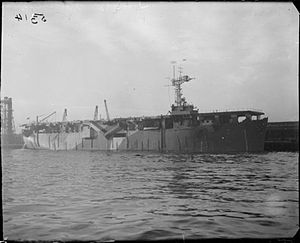 HMS Vindex
| |
| History | |
|---|---|
| Name | Vindex |
| Builder | Swan Hunter |
| Laid down | 1 July 1942[1] |
| Launched | 4 May 1943[1] |
| Commissioned | 3 December 1943[1] |
| Honours and awards |
|
| Fate | Sold into merchant service as Port Vindex 2 October 1947 and scrapped at Kaohsiung August 1971[1] |
| General characteristics | |
| Class and type | Nairana-class escort carrier |
| Displacement | 13,455 long tons (13,671 t) |
| Length | 524 ft (160 m) |
| Beam | 68 ft 6 in (20.88 m) |
| Draught | 21 ft (6.4 m) |
| Installed power | 11,000 hp (8,200 kW) |
| Propulsion |
|
| Speed | 17 kn (20 mph; 31 km/h) |
| Complement | 700 |
| Armament |
|
| Aircraft carried | 15–20 |
HMS Vindex (D15) was a Nairana-class escort carrier of the Royal Navy that saw service during the Second World War. She was built at Swan Hunter shipyards in Newcastle upon Tyne. When construction started in 1942 she was intended as a merchant ship, but was completed and launched as an escort carrier, entering service at the end of 1943.
Vindex operated escorting convoys and doing anti-submarine work in the Atlantic and Arctic theatres. Her Swordfish aircraft were involved in the sinking of four U-boats during her service. She survived the war, and immediately afterwards served in the Far East transporting men and material to and from Japan. In 1947, she was decommissioned and sold for commercial use, to Port Line and renamed Port Vindex. In 1971, she was scrapped in Taiwan.